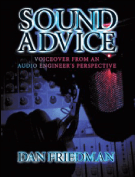Recording Magazine sends out a newsletter to its subscribers every few weeks. The newsletter is (coincidentally) titled “Sound Advice” and this month it features the ninth in a series about room acoustics. Room acoustics is one of the biggest concerns for Recording Magazine readers. I know that this is also a big issue for those of you in the voiceover world. I asked permission to reprint this newsletter (and will ask to reprint the others in the series as well) so that those of you with home studios can also benefit from the information. I want to personally thank Brent Heintz, VP/Associate Publisher for granting permission, allowing me to share this great information with you.
Please visit Recording Magazine‘s website and their Facebook Page.
Here is the ninth newsletter in the series on Room Acoustics:
Welcome to Sound Advice on Acoustics! We’ve started off this e-newsletter with a long multipart look at the basic concepts of acoustics and room treatment. In the coming months, we’ll have a variety of shorter articles on all manner of important acoustics ideas, reinforcing the basics and adding tips and tricks you can use in your room. But for now, let’s wrap up our primer with a few final notes, shall we?
This article has focused on control room acoustics, but the issues in the live (tracking) room are the same, though treatments will reflect the different usage of that space. Room modes introduce the same problems, and the same solutions apply. Additionally, being familiar with whatever standing waves may be present in the recording space can help the engineer in determining where to place instruments and microphones (to avoid a mic ending up in a null, for example).
Controlling reflections is also desirable in the live room, but here the criteria may be a bit different. In the recording room we might be more forgiving of colorations and echoes than in the control room. Rather than being a reference environment, the live studio space needs to support the sounds of singers and instruments, and here the acoustics may benefit from some “pleasant coloration” and enhancement of sound, though we certainly want to maintain control.
We may want to have different areas, some more ambient, some more dry (damped), to suit different recording situations, but this need not be implemented as rigorously as in the control room. One common approach to providing varying acoustics in the recording space is to mount two- or three-sided panels with different degrees of absorptive and reflective materials on the different faces. These panels can then be rotated individually to create the desired degree of ambience for a particular session.
In our discussion of control room acoustics we focused on early reflections and ambience, and didn’t really look at reverberation in detail, other than to point out the desirability of a diffuse sound field. In control rooms there’s very little reverb tail by design, so as not to overshadow the ambience and reverberation in recordings. In the live space, however, a good reverberant sound field is an asset, imparting a natural richness and dimension to recordings made there.
Had we focused on live room design, we’d have spent a lot more time discussing how to measure and control various aspects of the reverberant sound field via design criteria and room treatments. Fortunately, there’s no shortage of reference material available on this topic (see the recommended readings, and we’ll almost certainly get to this topic in a future installment of this e-newsletter!).
And there we are, several months after we started, with hopefully a good grasp of the basics. This article has tried to provide an introduction to the complexities of room acoustics, with a few practical suggestions for remedies and treatments. Anyone who plans to really get involved in designing and tuning the acoustics of a recording studio will want to delve much more deeply into the relevant physics and math. An excellent textbook on the subject is the Master Handbook Of Acoustics by F. Alton Everest, which contains both theoretical and practical information in great detail. Two other books that present practical design templates for DIY studio construction are Sound Studio Construction On A Budget, also by Everest, and How To Build A Small Budget Recording Studio From Scratch, by Mike Shea and F. Alton Everest (he does get around, doesn’t he!).
There’s also plenty of information to be found on the Internet that could be of help to any would-be studio designers out there (try the websites of some of the companies that make studio acoustic products, for starters). And to anyone who is designing and building their own recording space, large or small, good luck—it can be daunting, but the results will be worth it!
There’s lots more to learn and lots more to share… come back next month as we bring you more Sound Advice on Acoustics!



